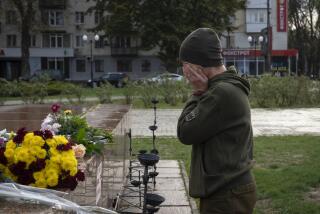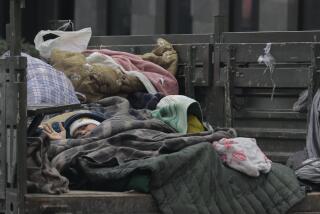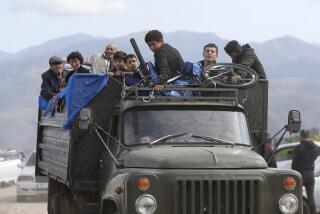Unrest Over in Armenia, Soviets Say : Some Strikes, Protests Continue; Troops Seal Off Capital, Towns
- Share via
MOSCOW — Soviet authorities said late Friday that the situation in the southern republic of Armenia had been brought under control, although protest rallies and strikes continued in some parts of Yerevan, the capital, and in other towns.
The official news agency Tass said security forces, including troops and police reinforcements, had taken “additional measures” Friday to end the mass protests and the general strike that had paralyzed Yerevan for nearly a week.
Tass gave no details, but residents in Yerevan, contacted by telephone, said that thousands of additional troops, supported by armored vehicles, had arrived there and in towns nearby. They said these forces had taken up positions at virtually every square, park and traffic circle and were preventing gatherings of more than four or five people.
Airlifts Reported
Wisconsin Lt. Gov. Scott McCallum arrived in Moscow from Yerevan and told reporters that at least 1,200 soldiers were deployed in the center of the city. He said more were arriving by plane as he left.
“In effect,” McCallum said, “the city is blockaded.”
West German tourists arriving in Tbilisi, the capital of neighboring Soviet Georgia, reported that tanks and armored cars had been driven into some crowds to break up the protests and that on several occasions, soldiers had fired their rifles over the heads of demonstrators.
Dissident sources in Moscow and Yerevan said a number of Armenian nationalist leaders had been arrested in a series of overnight police raids, but this could not be confirmed.
Armenian radio and television broadcast repeated appeals from prominent writers, musicians and educators for an end to the protests and a return to work in “a demonstration of self-control and soberness.” A similar appeal had been made earlier by Armenian political leaders.
A spokesman for the Armenian Foreign Ministry said by telephone from Yerevan that calm had been restored to the city and that factories, stores, offices and schools had begun to reopen with the restoration of some public transport.
“We are getting back to normal,” he said.
But Tass acknowledged that the authorities’ efforts to “stabilize the situation have been hampered by rallies organized by irresponsible elements in the center of Yerevan, where provocative statements are being made and rumors floated in a bid to stir people up.”
“Vremya,” the nightly news program on state-run Soviet television, showed knots of angry men in central Yerevan, with policemen and soldiers preventing them from moving into Opera Square, the focus of most of the demonstrations there over the past seven months.
Hundreds of thousands of people had thronged Opera Square and streets nearby until late Thursday, renewing their demand that Nagorno-Karabakh, a disputed region in neighboring Azerbaijan peopled by ethnic Armenians, be annexed by Armenia.
Several sympathetic members of the Armenian Supreme Soviet, the local legislature, had promised at the rally that they would ask for a special session of the assembly to review both the local situation and that in Nagorno-Karabakh, where Armenians and Azerbaijanis fought running battles over the weekend, leaving one person dead and 48 injured.
But on Friday, editors at local newspapers and Armenpress, the republic’s information agency, said the central Soviet authorities are opposed to further discussion of the emotional issue and are intent on restoring order.
“The word is that if it takes the whole Soviet army, these protests will be ended,” a journalist at a local Communist Party newspaper said, asking not to be quoted by name. “The decision has been made to be firm, to be hard, to be tough. . . .”
Tass reported that strikes were continuing Friday in Stepanakert, the principal city in Nagorno-Karabakh, although a state of emergency had been declared there Wednesday and a strict curfew imposed.
“Measures taken by law enforcement personnel in the Nagorno-Karabakh region and the (neighboring) Agdam district of Azerbaijan have made it possible to ease tension and prevent further inter-ethnic clashes,” Tass said. “People who set houses on fire have been arrested, and firearms and knives have been confiscated from individuals. An investigation is under way.”
Tass gave no further details, but state television showed large numbers of heavily armed troops patrolling Stepanakert on foot, supported by armored cars and armored personnel carriers.
With most transport into the region halted and most stores and markets closed, food is becoming scarce, according to reports from Stepanakert. Only bread and dairy products are now available, residents said, but this was more than the city had during a prolonged general strike that lasted nearly three months over the summer.
Soviet authorities have prohibited foreign correspondents from visiting the area, asserting that the situation is too disturbed.
More to Read
Sign up for Essential California
The most important California stories and recommendations in your inbox every morning.
You may occasionally receive promotional content from the Los Angeles Times.













